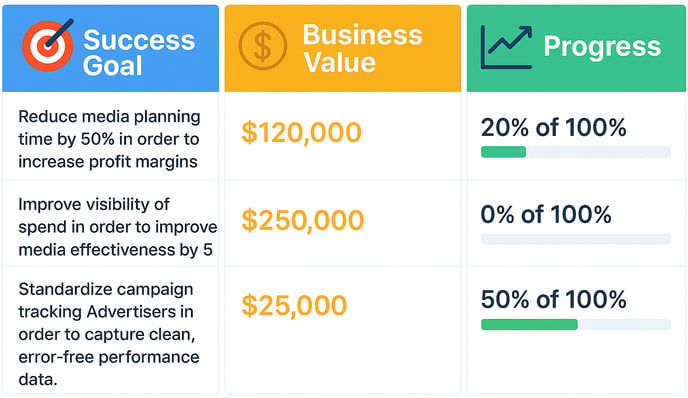Build Your Success Plan with Bionic
Understand what a success plan is, why it’s important, and how to create one with your team for Bionic for Agencies.
What is a Success Plan?
A success plan is a simple, shared document that defines what success looks like for your team when using Bionic. It gives you and the Bionic team a clear north star, so everyone is aligned on goals, value, and progress.
A success plan includes:
✅ A list of success goals: the problems you hope to solve and what you aim to achieve
✅ For each goal, the value if achieved: what is the economic value of achieving this goal
✅ A progress tracker: tracks the attainment of each goal.
Think of it as your roadmap for getting the most out of Bionic. 
Why is it Important?
A success plan is important as it helps you and your team to:
- Focus on business objectives, not just tasks
- Get measurable, demonstrable value from Bionic
- Align your team on priorities
- Make better decisions about how to use features and workflows
- Show your leadership real business impact
In this article, we’ll cover how to:
- Build a Success Plan
- See Example of a Success Plan
- Collaborate with Bionic on Your Success Plan
- Prepare for Your Success Plan Discovery Call
- Use Best Practices for Your Success Plan
Build a Success Plan

Define Your Goals
What do you hope to get out of Bionic from a business perspective? How can Bionic give you a competitive advantage?
Think about the biggest problems you want to fix, such as wasting time or making mistakes. Also think about new capabilities you want to unlock, such as better insights or more effective advertising.
Ask yourself what short-term (6-12 month) business objectives do you aim to achieve with Bionic?
Examples of goals:
- Reduce media planning time by xx% in order to increase profit margins.
- Improve visibility of cross-channel spend in order to improve media effectiveness by x%
- Standardize campaign tracking URLs across Advertisers in order to capture clean, error-free performance data.
- Reduce reconciliation errors and improve transparency in order to avoid over-payments and missing bills.
Estimate the Value
For each goal, we should understand the business value of attaining this goal. This helps to drive priorities so we focus our efforts on the things that matter the most for your business.
Some Examples:
- Save ~10 hours/month per planner = 10 × 12 months × $100 per hour × 10 planners = ~$120,000/year in productivity
- Enable better decisions that improves campaign effectiveness by 5% on $5M annual budget = 0.05 x $5 million = $250,000
- Save ~ 10 hours/month maintaining/updating = ~$5,000/year in productivity
- Reduce billing disputes, improving client trust = ~$8,000/year in billing errors
Track Progress
Now that you've set your goals and understand the value of each goal, it's important to track progress against each goal to understand the value that has been achieved.
Your plan will include a column to track Progress on a scale from 0% to 100%. This, in turn, will drive the calculation for Value Realized where:
Value Realized = Business Value × Progress
For example:
Value Realized = $100,000 Business Value × 70% Progress = $70,000
Progress will be revisited during regular check-ins to see what’s on track and what needs attention.
See Example of a Success Plan

Collaborate With Bionic on Your Success Plan
Your Bionic Customer Success Manager will guide you through this process:
✅ Facilitate a discussion with your team to define goals
✅ Help you quantify value
✅ Draft and share the plan document with you
✅ Review it regularly in check-ins or Quarterly Business Reviews (QBRs)
Please come prepared to discuss your business goals. Don't worry if it's not perfect. We’ll help you shape them, and this will serve as a "living document" that is always open to revision.
Prepare for your Success Plan Discovery Call
Before building your Success Plan in Bionic, you’ll have a Discovery Call with the Bionic Customer Success team. This collaborative session is designed to understand your business goals, challenges, and what success looks like for your team.
To get the most value from the session, take a few minutes to review what a Success Plan is and come with a short list of your goals, priorities, success metrics, and what you'd like to accomplish.
What is discussed:
-
Your top business priorities for this project
-
Any workflow challenges or inefficiencies
-
Success metrics that matter to your team
Here are some questions we’ll walk through together:
- What are your top business priorities as it relates to this project?
- How do you see Bionic supporting these goals?
-
Are there steps in your process that frequently lead to mistakes or confusion?
- Where do you feel your team is wasting the most time right now?
- Are there internal processes that feel more costly or effort-heavy than they should be?
- Are there specific business metrics you’re trying to improve?
This Success Plan Discovery slide deck will be referenced during the session.
Use Best Practices for Your Success Plan
Here are some best practices when creating your success plan:
✅ Bring your ideas to the next onboarding or check-in call
✅ Collaborate with the Bionic team to help you fill in the plan
✅ Keep it visible for your team as a shared goalpost
✅ Always continue to iterate as success goals pivot or change